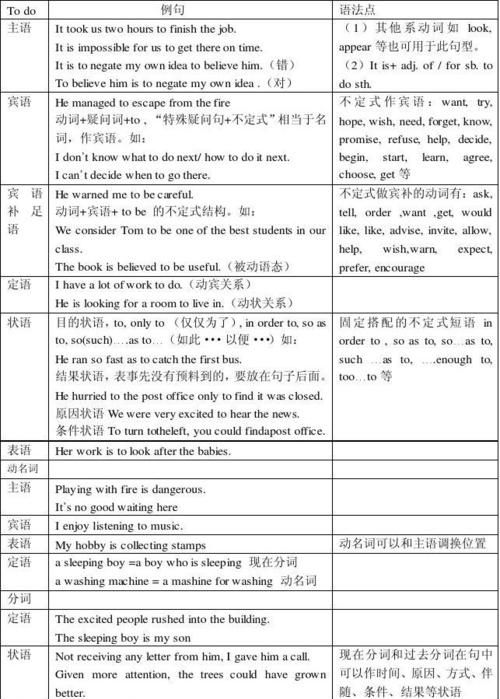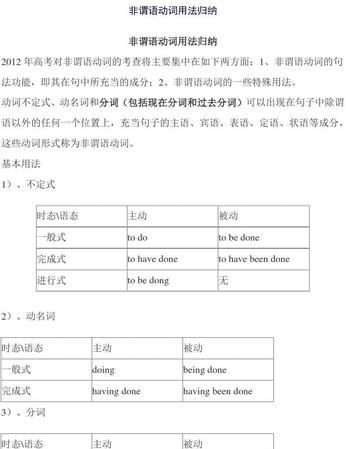本文目录
非谓语可以在谓语之前吗
非谓语可以在谓语动词之前。
当非谓语动词作状语时,可以用动词不定式或分词,可以放在谓语动词的前面,也可以放在谓语动词的后面,还可以插在句子的中间。
此外,非谓语动词还有一般式、完成式、进行式和完成进行式的区别。一般式是表示非谓语动词的动作和谓语的动作同时发生,完成式表示非谓语动词的动作发生在谓语动词的动作之前,进行式表示非谓语动词的动作和谓语动词的动作同时发生,而完成进行式表示非谓语动词的动作从谓语动词的动作之前开始就一直在持续。

非谓语动词怎么用三种形式
动词的非谓语形式有三种:不定式、动名词和分词。
不定式
不定式由“to+动词原形”构成,其否定形式是“not to do”。不定式可以带宾语或状语构成不定式短语。不定式没有人称和数的变化,有时态和语态的变化。不定式可以作主语、宾语、状语、表语和定语。不定式复合结构为“介词+sb.(sth.)+to do”,其中“介词+sb.(sth.)”表明不定式动作的发出者,为逻辑主语。
1. 不定式的用法:
(1)作主语。不定式短语作主语时,为了使句子结构平衡,常将不定式短语放在谓语之后,而用it作形式主语。
It is our duty to give as much help as possible. 提供尽可能多的帮助是我们的职责。
但不定式作表语时,前面有不定式作主语,不定式不可位于句末。
To see is to believe. 眼见为实。
(2)作宾语。常见的只跟不定式作宾语的动词(组)有want, wish, hope, expect, would like (love),care, choose, learn, plan, prepare, mean, agree, promise, offer, refuse, ask, beg, decide, make up one’s mind, be determined, manage, try, can’t afford, fail, pretend等。
①He promised to come today, but he hasn’t turned up yet .
他许诺说今天来,但他到现在还没有出现。
②No one likes to be laughed at. 没人喜欢被嘲笑。
有形容词、分词、名词作宾补,不定式作宾语时要将不定式放于句末,用it 来作形式宾语。如:
You may find it necessary to finish the work ahead of time.
你会发现有必要提前完成工作。
(3)作宾语补足语。常见的跟不定式作宾补的动词有ask, order, advise, like, want, teach, force, forbid, beg, allow, expect, cause, invite, tell, know, call on, depend on, wait for等。
The children asked their parents to take them to the park.。
孩子们要求父母带他们去公园。
感官动词后,如 see, watch, look at, observe, notice, hear, listen to, feel及部分表示“使”、“让”的使役动词,如have, make, let 跟不定式作宾补时要省略不定式符号to。但在被动语态中to 要加上。
Though he had often made his sister cry, today he was made to cry by his sister.
尽管他总是弄哭他妹妹,今天却被妹妹弄哭了。
help后的不定式作宾补(包括作宾语)to 可有可无。
(4)作表语。
My job is to help the patient. 我的工作是帮助病人。
要注意不定式作表语与“be to do”结构的不同:
不定式作表语说明主语的性质或内容,而“be to do”结构表示安排要做的事情。
①My next plan is to draw a picture for the house.(不定式作表语)
我下一个计划是为这座房子画一幅图。
②We are to meet at the school gate at six .(be to do表示安排)
我们约好六点在学校门口见面。
(5)作定语
①表示将来的动作。
The meeting to be held next week will be of great importance.。
下周将要举行的会议极为重要。
② 用在固定搭配中。
I will go to Shanghai tomorrow. Have you anything to be sent to your son?
我明天要去上海,你有什么东西要带给你儿子吗?
(send的动作发出者并非you,因此不定式用被动语态)
作定语的不定式如果与其前面所修饰的名词有逻辑上的动宾关系,然而动词又为不及物动词,动词后要加介词或副词,使其成为及物动词词组。
Will you find me a pen to write with? 你能给我找一支写字的笔吗?
不定式所修饰的词是time, place, way时,不定式后面的介词习惯上要省去。
Do you think it is the best way to deal with such a problem?
你认为这是解决问题的最好方式吗?
(6) 状语。表示目的、原因、结果。
①They ran over to welcome the guests. 他们跑过去欢迎客人。(目的)
②The child is too young to go to school. 孩子太小不能去上学。(结果)
③We were excited to hear the news. 听到这个消息我们激动了。(原因)
不定式的时态与语态
不定式有一般式、进行式、完成式形式,既有主动语态又有被动语态两种语态。形成to do, to be done, to be doing,to have done, to have been done形式。
(1)不定式的一般式所表示的动作通常与谓语的动作(状态)同时(或几乎同时) 发生,或是在它之后发生。
I’m sorry to tell you that you are wrong this time.
我很遗憾告诉你这次是你错了。
(2)如果谓语表示的动作(情况)发生时,不定式表示的动作正在进行, 这时不定式就要用进行式。
I am very glad to be talking with you. 我很高兴与你交谈。
(3)如果不定式的动作发生在谓语动词之前,就要用完成式。
I’m sorry to have kept you waiting for such a long time. 对不起,让你久等了。
当不定式逻辑上的主语是这个不定式所表示的动作的承受者时, 不定式要用被动语态。
He asked to be sent to work in the countryside. 他要求去农村工作。
动名词
动名词由“动词+ing”构成;具有动词和名词的性质,可以有宾语或状语; 可作主语、宾语、表语和定语。动名词有时态和语态的变化。
1. 动名词的作用
(1)作主语。
动名词短语作主语时,为了使句子平衡,常将动名词短语放在谓语之后,而用it作形式主语。
It is useless arguing with him about such a matter. 跟他争论这样的事情是没用的。
动名词和不定式都可作主语,在许多情况下可以通用,但动名词作主语多表示一般或抽象或多次的行为,不定式作主语往往表示具体的或一次性的动作。
在 It is no use/good, not any use/good, useless后人们习惯上用动名词。
(2)作宾语
下列动词(组)只能接动名词作宾语
admit, advise, allow, appreciate, avoid, consider, delay, enjoy, escape, excuse, finish, imagine, mind, pardon, permit, practise, suggest, require, be (get) used to(习惯于...), cant’t help(禁不住), feel like, set about, stick to, keep on, look forward to, devote oneself to, insist on, pay attention to, be worth, give up, put off。
下列动词后跟不定式或动名词意义区别不大:
begin, start, love, continue, hate, prefer。
下列动词后跟不定式或动名词意义不同,在平时学习中应特别注意。
forget, remember, regret, try, stop, mean, go on, can't help。
下列动词后跟动名词主动语态,不定式被动语态作宾语表示被动。
need, want, require。如:
These clothes need mending (to be mended).
(3) 作表语
动名词作表语多表示抽象性的或习惯性的动作,当表示下一步打算时多用不定式作表语。
①My job is teaching you English. 我的工作是教你英语。
②Her next step is to get as much money as she could to build the factory.
她下一步是获取尽可能多的资金建造工厂。
(4)作定语
动名词作定语表示用途,而不是正在进行着的动作。
He is now in the sleeping car. 他现在在房车里。
2. 动名词的复合结构
动名词的复合结构指在动名词前加物主代词或名词所有格。物主代词或名词所有格表明动名词动作的发出者。
His coming late made the teacher angry. 他的迟到让老师生气。
动名词的复合结构在句中作宾语时,物主代词或名词所有格可以变为人称代词的宾格或名词的普通格,但复合结构作主语时不变任何变化。
He entered the room without anyone noticing him.
他进入房间,没有人察觉到他。
Li Ming’s smoking ( 不可用Li Ming smoking) in the classroom surprised us.
李明在教室里吸烟让我们很吃惊。
3. 动名词的时态与语态
动名词的时态分为一般式和完成式两种形式。如果动名词的动作发生在谓语动词之前,则运用完成式;如果与谓语动词的动作同时发生或在其后发生,用一般式。
I’m sorry for not having kept my promise.
对不起,我没有遵守诺言。
若动名词与其逻辑主语有被动关系,则运用被动语态形式。( 但有些动词后运用主动形式表达被动概念,除上述动词外,be worth后也跟动名词主动形式表达被动概念)。
He entered the room without being noticed.
他进入房间而没被察觉。
分词
分词分为现在分词和过去分词。
1. 区别
(1)现在分词表示主动,过去分词表示被动。
①The man standing by the window is our teacher.
②The house built last year has become our lab.
(2)现在分词表示事物本身所具有的性质,意为“令人……的”; 过去分词表达由外界引起的内心活动,意为“感到……的”。
the exciting news 激动人心的消息。(令人兴奋的消息)
the excited look 激动的表情。
(3) 现在分词表达正在进行着的动作,过去分词表达完成的动作。(这一类动词主要为不及物动词)
①Electricity lines as well as telephone poles were brought down by falling trees or branches.
②The army was called in to cut through fallen trees and... .
2.分词的时态和语态
过去分词表示被动或完成的动作,因而没有完成式和被动语态。
现在分词有一般式和完成式两种形式, 有主动语态和被动语态两种语态,形成doing, having done, having been done的形式。
3. 分词的用法
(1)作定语
单个分词作定语一般放在所修饰词的前面,短语作定语放在所修饰词的后面。
①The question being discussed is important to us.
②The excited people rushed into the building.
(2)作状语
分词或分词短语作状语时,可以表示时间、原因、行为方式、结果、伴随状况等。
①Having been shown around the lab, we were led into a big hall. (时间)
②Being a student, I must study hard.(原因)
③They worked day and night, finishing the work ahead of time.(结果)
不定式也可以作结果状语,然而不定式多表达意料之外的结果,而现在分词表达意料之中的结果。
①She went to Shanghai specially to see her brother, only to find that he had gone to Beijing a few days before.
她专程去上海看望她的兄弟,却发现他几天前去了北京。
②They got up very early that day, finding nobody in the station when they got there.
那天他们很早就起床了,到了车站却发现那里空无一人。
(3)作表语
①The news is inspiring. 这消息令人鼓舞。
②The window is broken. 窗户破了。
(4)作宾补
①We had the fire burning all day. 我们让这火整天烧着。
②I’m afraid I can't make myself understood when I speak English.
我担心当我说英语是别人听不懂。
不定式被动语态、现在分词被动语态、过去分词表示被动应该注意的几个问题。
1. 不定式的被动语态作状语时多表达目的,相当于in order to be done, 而过去分词则表示原因、条件、伴随等;现在分词被动语态的完成式强调分词的动作发生在谓语动词动作之前。
①In the circus, the tamed animals will be given some food when they finish tricks. To be given more food, the animals will try their best to please the trainer.
在马戏团里,当驯兽完成它们的把戏,会得到一些食物。若要得到更多食物,它们就要尽其所能来取悦驯兽师。
(To be given...=In order to be given...,表示目的,此处不可用Given 或 Being given)
②Having been asked some very difficult questions, the boy came into the office.
男孩被问了一些很难的问题后,来到办公室里。
(Having been asked...=After he was asked..., 表示ask 的动作发生在come 之前)
2. 不定式的被动语态作定语表达将来的动作, 过去分词作定语表达过去或完成的动作,现在分词被动语态的一般式表达一种正在进行的动作。
①The meeting to be held next week is about how we can deal with this problem.
下周要开的会是关于我们如何解决这个问题的。
(to be held=which is to be held, be to 在此表达将来)
②The book published last month sells well. 上月出版的那本书卖得很好。
( published = which was published, published不可用to be published或being published代替)
③The building being built now will be finished in ten days. 正在建筑的那栋楼,10天内完工。
(being built=which is being built, 表示正在进行的动作)
3. 作宾补时,若非谓语动词与其前面的宾语有逻辑上的被动关系, 表示感官的动词,如 see, find, watch, notice, hear, feel 及部分使役动词,如:have, keep, get, let 等后跟过去分词作宾补;allow, advise,forbid, permit, want, order 等后跟不定式被动语态作宾补。
①The Emperor ordered the cloth to be woven for him right away.
皇帝命令说立刻为他织那块布。
②When she got home, she found her windows broken.
当她回到家时,发现窗户破了。

非谓语动词三种情况怎么用
非谓语动词和谓语动词的相对时间关系 非谓语动词
相对谓语动词的时间意义 例句
一般式不定式
说明行为在谓语动词所表示的行为之后,多数是那些表愿望的词:want; hope; expect; wish等。 I want to go home.
I hope to see you.
说明行为与谓语动词表示的行为同时发生,多数是那些省略不定式符号的词,一般是复合宾语。 I saw him come in.
He helped him (to) carry things.
一般式动名词
表示动作与谓语动词表示的动作同时发出。 We enjoyed seeing the film.
I am thinking of taking over the job.
在动词insist on; rely on; count on(相信)等后表示动作在谓语动词表示的动作之后发生。 He insisted on doing that work
在有些明确表示时间先后的动词和介词on; upon after代替完成动名词表示的动作在谓语动词表示的动作先发生。 I remember seeing him before.
On arriving Beijing, he went to see his friend.
一般式分词
现在分词
持续性动词
说明分词表示的动作和句中谓语动词表示的动作同时发生。 He stood there speaking.
Holding a book under his arm, he entered the room.
终止性动词
说明分词表示的动作发生之后,句中谓语动词表示的动作立刻发生。 Entering the room, I found nobody in.
Turning to the right, you will find the post office.
过去分词
持续性动词
通常说明分词表示的动作,此句中谓语动词表示的动作先发生。 Written in simple English, the book is easy to read.
I can't find my lost pen.
说明分词表示的动作和句中谓语动词表示的动作并无先后。 He is a person well-known in this country.
代替完成式现在分词的被动语态。 Educated by the party, he became a brave fighter.
完成式不定式
说明行为动词在谓语动词表示的行为动词之前发生。 I'm sorry to have troubled you.
He is said to have come here.
He is thought to have done it.
He is believed to have done it.
He seemed to have known it.
在wish, hope, expect, intend, mean, suppose等动词过去时后,说明行为动词没有实现。 We wished to have done this.
I expected to have left by then.
(=I had expected to heave by then.)
完成式动名词
说明动名词表示的动作,此句中动词表示的动作先发生。 We regret having told you the news.
After having finished his work, he went home.
He denied having broke the glasses.
完成式分词
说明分词表示的动作,此句中谓语动词表示的动作先发生。多数表示一些瞬时间动词。如果是hear; see或表示位置转移的动词arrive; leave; turn; open.不用完成时 Having finished his work, he went home.
Sitting down with him, we begun to discuss it.
Hearing this, he rose and went to the door.
非谓语动词用法对比
知识要点:
一、不定式与动名词做主语:
1、动名词做主语往往表示普通的、一般的行为,不定式做主语常表示某次具体的行为。例如:
Collecting information about children’s health is his job. 收集有关儿童健康的信息是他的工作。
It’s necessary to discuss the problem with an experienced teacher. 与一位有经验的老师讨论这个问题是有必要的。
2、常用不定式做主语的句型有:
(1)It’s difficult (important, necessary) for sb. to do
(2)It’s kind (good, friendly, polite, careless, rude, cruel, clever, foolish, brave) of sb. to do.
3、常用动名词做主语的句型有:
It’s no good (use, fun) doing.
It’s (a) waste of time one’s doing.
It’s worth while doing.
二、不定式、动名词、分词做表语:
1、不定式做表语常表示谓语动词所表示动作之后发生的动作。
His teaching aim of this class is to train the students’ speaking ability. 他这节课的教学目的是要训练学生说的能力。
2、动名词做表语是对主语内容的解释,这时主语与表语位置可以互换,动名词常用于口语中。
Its full-time job is laying eggs. 它的(指蚁后)的专职工作是产卵。
3、现在分词做表语表示主语的性质与特征;进行时表示正在进行的动作。
The task of this class is practising the idioms. (现在分词做表语)
With the help of the teacher, the students are practising the idioms. (现在进行时)
4、常用作表语的现在分词有:interesting, amusing, disappointing, missing, puzzling, exciting, inspiring, following等。现在分词表示进行与主动。
The joke is amusing .这笑话很逗人。
The problem is puzzling. 这个问题令人不解。
5、过去分词作表语表示主语所处的被动状态或完成某动作的状态。而被动语态表示主语所承受的动作。
The village is surrounded by high mountains.(过去分词做表语)
The enemy was surrounded by the Red Army.(被动语态)
He is well educated.(过去分词做表语)
He has been educated in this college for three years.(被动语态)
常用在句中做表语的过去分词有:
used, closed, covered, interested, followed, satisfied, surrounded, done, lost, decided, prepared, saved, shut, won, completed, crowded, dressed, wasted, broken, married, unexpected等。
6、注意如下动词的现在分词与过去分词用法不同:
interest(使…感兴趣),surprise(使…吃惊),frighten(使…害怕),excite(使…兴奋),tire(使…疲劳),please(使…满意),puzzle(使…迷惑不解),satisfy(使…满意),amuse(使…娱乐),disappoint(使…失望),inspire(使…欢欣鼓舞),worry(使…忧虑)
它们的现在分词常修饰物(有时修饰人),表示主动,过去分词常修饰人,表示被动(包括某人的look、voice等)。例如:
Climbing is tiring. 爬山很累人。
They are very tired. 他们很疲劳
After hearing the exciting news, he gave a speech in an excited voice.
三、不定式与动名词做宾语:
1、下列动词跟不定式做宾语:
want, wish, hope, expect, ask, pretend, care, decide, happen, long, offer, refuse, fail, plan, prepare, order, cause, afford, beg, manage, agree, promise等。
2、在下列动词或动词短语后用动名词做宾语:
enjoy, finish, suggest, avoid, excuse, delay, imagine, keep, miss, appreciate, be busy, be worth, feel like, can’t stand, can’t help, think of, dream of, be fond of, prevent…(from), keep…from, stop…(from), protect…from, set about, be engaged in, spend…(in), succeed in, be used to, look forward to, object to, pay attention to, insist on等。
3、在forget, remember, stop, regret, try, mean等动词后跟不定式与动名词意义不同,不定式表示谓语动词之后的动作,而动名词表示的动作发生在谓语动词之前,常用一般式doing代替完成式having done.
He forgot to tell me to post the letter.(他忘了叫我发信。)
I shall never forget finding that rare stamp on an ordinary envelope. 我永远也忘不了在一个普通信封上发现了那枚珍贵的邮票。
Remember to write to us when you get there. 到那里,记得给我们写信。
I don’t remember meeting him. 我不记得见过他。
I regret to tell you that I can’t go to your birth-day party. 我很遗憾告诉你我不能去参加你的生日晚会了。
They regretted agreeing to the plan. 他们后悔同意这个计划。
He tried to pretend to share in the pleasure with his friend. 他尽力假装与朋友分享欢乐。
She tried reading a novel, but that couldn’t make her forget her sorrow. 她试着看看小说,但也不能使她忘记伤心事。
I didn’t mean to hurt you. 我没有企图伤害你。
A friend indeed means helping others for nothing in return. 真正的朋友意指不图回报地帮助别人。
4、动名词作need, want, require, be worth的宾语时,用主动式代替被动式。
The washing-machine needs repairing.(或用:needs to be repaired)这台洗衣机需要修理。
The point wants referring to. 这一点要提到。
This English novel is worth reading. 这本英文小说值得一读。
The situation in Russian required studying. 俄国形式需要研究。
四、不定式与分词在句中做宾语补足语:
1、以下动词后跟不定式做宾语补足语:
ask, tell, beg, allow, want, like, hate, force, invite, persuade, advise, order, cause, encourage, wait for, call on, permit, forbid
The doctor advised him to stay in bed for another few days. 医生嘱咐他再卧床休息几天。
We wish him to remain and accept the post. 我们希望他留下来接受这个职位。(注意hope后不跟不定式做宾补。)
2、有些动词后的复合宾语用不带“to“的不定式,这些动词有:see, watch, notice, hear, feel, make, let, have等。例如:
We noticed him enter the house. 我们留意到他进了那所房子。
The boss made them work twelve hours a day. 老板让他们一天干12小时工作。
注意当make、have不做“迫使、让”讲,而做“制造、有”解时,跟带有to的不定式做状语。
Mother made a cake to celebrate his birthday. 妈妈做了一个蛋糕给他庆贺生日。
He had a meeting to attend. 他有个会要开。
3、下列动词后的复合宾语用分词做宾补:see, watch, notice, observe, hear, feel, make, set, have, leave, keep, find等。用现在分词还是用过去分词做宾补,要看分词与宾语的关系。例:
We heard him singing the song when we came in. 当我们进来的时候,听见他正唱那首歌。
We have heard the song sung twice. 我们听过这首歌唱过两遍了。
五、非谓语动词做定语:
1、不定式做定语放在所修饰的名词后,表示在谓语动词之后发生的动作或过去的某一特定动作。例如:
He had no house to live in but a lot of work to do. 他没有房子住却有好多活要干。
Our monitor is the first to arrive. 我们班长是第一个到的。
2、动名词与现在分词做定语的区别:
动名词做定语说明所修饰名词的用途;现在分词做定语,表示所修饰名词进行的动作。
a walking stick 拐杖(动名词做定语,意为a stick for walking)
a sleeping car 卧铺车厢(动名词做定语,意为a car for sleeping)
the rising sun 正在升起的太阳(现在分词做定语,意为the sun which was rising)
the changing world 变化中的世界(现在分词做定语,意为the world which is changing)
3、现在分词与过去分词做定语的区别:过去分词做定语表示完成或被动的动作,现在分词做定语表示主动或进行的动作。如:
a piece of disappointing news 使人失望的消息(意同a piece of news which disappointed us)
in the following years 在后来的几年中(意同in the years that followed)
a well dressed woman 衣着讲究的女士(意同a woman who is dressed well)
a car parked at the gate 停在门口的小汽车(意同a car which was parked at the gate)
六、不定式与分词做状语:
1、不定式做状语,只表示目的、结果或原因:
He hurried home only to find his money stolen. 他匆忙赶到家中,发现钱被盗了。(结果状语)
To make himself heard, he raised his voice. 为了被听清楚,他提高了嗓门。(目的状语)
All of us are surprised to see his rapid progress. 看到他的进步,我们都很吃惊。(原因状语)
2、分词做状语可表示时间、条件、原因、伴随、让步、方式:
Seen from the top of the hill, the town is beautiful. 从山上看,这座城市很美。(条件状语)
Coming into the room, he found his father angry. 当走进房间时,他发现父亲生气了。(时间状语)
Being tired, they went on working. 虽然累了,但他们继续工作。(让步状语)
Having been hit by the big boy on the nose, the little boy began to cry. 由于被大孩子打了鼻子,那个小男孩哭了。(原因状语)
He put a finger in his mouth, tasted it and smiled, looking rather pleased. 他把一个手指放进嘴里,尝了尝,笑了,看起来挺高兴。(伴随状语)

英语中的谓语和非谓语的形式和用法区别
谓语动词和非谓语动词的区别:
1) 谓语动词在句中可单独作谓语,而非谓语动词不能单独作谓语.
Miss Mary teaches us English.
玛丽教我们英语.(teaches 动词作谓语)
Mr.Victor came to our classroom to have a talk with us last week.
维克托先生上周来到了我们教室和我们谈话. (to have a talk. 不定式作状语)
2) 谓语动词受主语的人称和数的限制,而非谓语动词形式没有这种限制.
Larke likes the pop music.
拉克喜欢流行音乐. (动词用单数第三人称形式)
Larke has nothing to do today.
拉克今天没什么事要做.(do 用原形)
非谓语动词的特征:
1 如果非谓语动词是及物动词,后面须跟宾语.
Studying English is my favorite.
学习英语是我的爱好.(studying 后跟宾语)
To help him is my duty.
帮助他是我的责任.(help 后跟宾语)
2 非谓语动词可以带有自己的状语或逻辑主语.
Working under such a condition is terrible.
在这样的环境下工作太可怕了.(under such a condition 是 working 的状语)
It's too difficult for him to master English in such a short time.
他在这么短的时间内掌握英语太难了.(for him 作不定式的逻辑主语)
3 非谓语动词仍有语态和时态的变化.
I am sorry to have kept you waiting long.
对不起让你久等了.(to have kept...是不定式的完成形式)
Seen from the mountain, the city looks much more beautiful.
从山上看,这座城市美丽多了.(Seen from...是分词的被动形式)
4 非谓语动词在句中可以当成名词或者形容词来使用.
Our coming made him happy.
我们的到来使他很高兴.(coming 起名词作用)
There are two big swimming pools here.
这儿有两个大型游泳池.(swimming 起形容词作用

以上就是关于非谓语动词用在谓语后用哪个,非谓语可以在谓语之前吗的全部内容,以及非谓语动词用在谓语后用哪个 的相关内容,希望能够帮到您。

